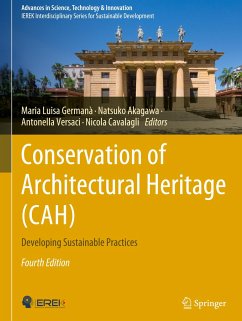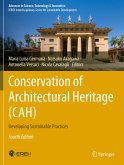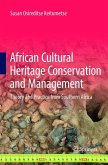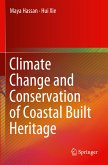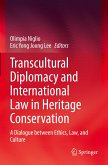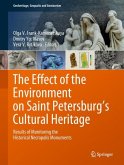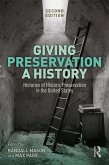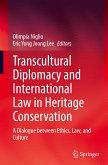Conservation of Architectural Heritage (CAH)
Developing Sustainable Practices
Herausgegeben:Germanà, Maria Luisa; Akagawa, Natsuko; Versaci, Antonella; Cavalagli, Nicola
Conservation of Architectural Heritage (CAH)
Developing Sustainable Practices
Herausgegeben:Germanà, Maria Luisa; Akagawa, Natsuko; Versaci, Antonella; Cavalagli, Nicola
- Gebundenes Buch
- Merkliste
- Auf die Merkliste
- Bewerten Bewerten
- Teilen
- Produkt teilen
- Produkterinnerung
- Produkterinnerung
This book presents practical, applicable solutions that contribute to built heritage conservation, discussing challenges like resource constraints, ineffective legislation, lack of coordination between different relevant bodies, and absence of public awareness and involvement. This is to maintain the beauty and cultural meaning of the architectural heritage since they are like a glimpse from the past life, representing how people lived, their religions, and beliefs in addition to the primitive but inspirational technology used in construction. As a result, this book is of significant…mehr
Andere Kunden interessierten sich auch für
![Conservation of Architectural Heritage (CAH) Conservation of Architectural Heritage (CAH)]() Conservation of Architectural Heritage (CAH)138,99 €
Conservation of Architectural Heritage (CAH)138,99 €![African Cultural Heritage Conservation and Management African Cultural Heritage Conservation and Management]() Susan Osireditse KeitumetseAfrican Cultural Heritage Conservation and Management82,99 €
Susan Osireditse KeitumetseAfrican Cultural Heritage Conservation and Management82,99 €![Climate Change and Conservation of Coastal Built Heritage Climate Change and Conservation of Coastal Built Heritage]() Maya HassanClimate Change and Conservation of Coastal Built Heritage82,99 €
Maya HassanClimate Change and Conservation of Coastal Built Heritage82,99 €![Transcultural Diplomacy and International Law in Heritage Conservation Transcultural Diplomacy and International Law in Heritage Conservation]() Transcultural Diplomacy and International Law in Heritage Conservation104,99 €
Transcultural Diplomacy and International Law in Heritage Conservation104,99 €![The Effect of the Environment on Saint Petersburg's Cultural Heritage The Effect of the Environment on Saint Petersburg's Cultural Heritage]() The Effect of the Environment on Saint Petersburg's Cultural Heritage64,99 €
The Effect of the Environment on Saint Petersburg's Cultural Heritage64,99 €![Giving Preservation a History Giving Preservation a History]() Giving Preservation a History160,99 €
Giving Preservation a History160,99 €![Transcultural Diplomacy and International Law in Heritage Conservation Transcultural Diplomacy and International Law in Heritage Conservation]() Transcultural Diplomacy and International Law in Heritage Conservation104,99 €
Transcultural Diplomacy and International Law in Heritage Conservation104,99 €-
-
-
This book presents practical, applicable solutions that contribute to built heritage conservation, discussing challenges like resource constraints, ineffective legislation, lack of coordination between different relevant bodies, and absence of public awareness and involvement. This is to maintain the beauty and cultural meaning of the architectural heritage since they are like a glimpse from the past life, representing how people lived, their religions, and beliefs in addition to the primitive but inspirational technology used in construction. As a result, this book is of significant importance to professionals in the fields of architecture, sustainability, as well as policymakers.
Hinweis: Dieser Artikel kann nur an eine deutsche Lieferadresse ausgeliefert werden.
Hinweis: Dieser Artikel kann nur an eine deutsche Lieferadresse ausgeliefert werden.
Produktdetails
- Produktdetails
- Advances in Science, Technology & Innovation
- Verlag: Springer / Springer International Publishing / Springer, Berlin
- Artikelnr. des Verlages: 978-3-031-33221-0
- 4. Aufl.
- Seitenzahl: 472
- Erscheinungstermin: 10. Februar 2024
- Englisch
- Abmessung: 285mm x 215mm x 30mm
- Gewicht: 1533g
- ISBN-13: 9783031332210
- ISBN-10: 3031332210
- Artikelnr.: 67772607
- Herstellerkennzeichnung Die Herstellerinformationen sind derzeit nicht verfügbar.
- Advances in Science, Technology & Innovation
- Verlag: Springer / Springer International Publishing / Springer, Berlin
- Artikelnr. des Verlages: 978-3-031-33221-0
- 4. Aufl.
- Seitenzahl: 472
- Erscheinungstermin: 10. Februar 2024
- Englisch
- Abmessung: 285mm x 215mm x 30mm
- Gewicht: 1533g
- ISBN-13: 9783031332210
- ISBN-10: 3031332210
- Artikelnr.: 67772607
- Herstellerkennzeichnung Die Herstellerinformationen sind derzeit nicht verfügbar.
Maria Luisa Germanà is a full professor of Technological Design of Architecture. She is an architect, and she earned her Ph.D. in Building and Environmental Refurbishment in 1992. With more than 20 years of academic experience, she has held several institutional roles in her university and in the national scientific society of architectural technology (SITdA). Professor Maria Luisa Germanà has more than 140 published books, chapters and articles, and she has been invited as a member of peer-review board of national and international journals and of scientific council of book series. She has been a principal investigator of international and national research projects. She has gained an extensive teaching experience, tutoring more than 100 bachelor's and master's degrees and Ph.D. students. Her main themes of research (Architectural Heritage; Environmental Design; Rural and Vernacular Architecture; Ecological Building Materials; Refurbishment, Management and Maintenance of the Built Environment) are different facets of a holistic scientific interest, focused on the sustainability of the processes of formation, transformation and management of the most varied examples of built environment and based on the systemic and process-based approach supported by the technological disciplines. Lately, she has joined ICOMOS, and she has been admitted as an expert member of International Committee on Archaeological Heritage Management (ICOMOS ICAHM) and of the International Scientific Committee on Earthen Architectural Heritage (ICOMOS ISCEAH). Dr. Natsuko Akagawa is tenured at the University of Queensland. She is a longstanding expert member for International Council on Monuments and Sites (ICOMOS), an expert member of International Committee for Vernacular Architecture (ICOMOS), an expert member and a former vice president of International Scientific Committees for Intangible Cultural Heritage (ICOMOS) and a member of the International Council of Museums (ICOM). She is regularly invited as a keynote speaker and has been a member of editorial and peer-review boards for numerous high-impact international journals. She is also the series general editor for Routledge Research on Museums and Heritage in Asia (Routledge). Dr. Akagawa is the author of Heritage conservation in Japan's cultural diplomacy: Heritage, national identity and national interest (Routledge 2014), the seminal work theorizing Heritage and Cultural Diplomacy, and the co-editor of Safeguarding Intangible Heritage (Routledge 2019) and Intangible Heritage (Routledge 2009), all internationally influential studies on Intangible Heritage. She has also worked on a number of projects with heritage conservation practitioners as a principal investigator and with academics in developing policy documents. Antonella Versaci is a researcher and an assistant professor at the Faculty of Engineering and Architecture, University "Kore" of Enna, where she is responsible for the "Laboratory of Restoration of Architectural and Cultural Heritage" and teaches "architectural restoration" and "laboratory of architectural restoration" within the Master of Architecture. She is also an associate researcher at the Institut Parisien de Recherche Architecture Urbanistique Société (IPRAUS), a research laboratory of the ENSAPB-National Superior School of Architecture of Paris-Belleville (UMR 3329 Ausser). Her research applies to the issues of safeguarding and conservation of historic buildings and landscape, with particular attention to cultural heritage spread across the territory and to the protection of historic centers, as well as to their survey, diagnosis, classification and valorization. In 1996, she earned a master's degree in Building Engineering at the University of Messina and, the following year, obtained a scholarship for postgraduate specialization courses abroad. She then attended in Paris two courses of specialization in urban preservation, strategic planning and management earning both degrees. In 2005, she received a Ph.D. degree cum laude in "Architecture" from the University of Paris VIII, with a dissertation on the legislation on historic centers in France. From June 2004 to September 2008, she was a UNESCO international staff member, responsible for numerous cultural projects in Southeastern Europe, including those related to the creation of a School of Restoration in Tirana (Albania) and to a Center for Digitization of Heritage Cultural in Skopje (FYROM). She is the author of over 90 refereed publications. Dr. Nicola Cavalagli currently holds an assistant professor position at the University of Perugia in Italy. He is a lecturer of the course of Mechanics of Historic Constructions and of the Laboratory of Architectural Restoration since 2015. His research interests are mainly focused on the analysis of historical constructions, with special attention to the homogenization techniques of masonry material and the analysis of masonry arches, vaults and domes, considering geometrical uncertainties effects. Recent studies have been devoted to the development of Structural Health Monitoring Strategies applied to heritage constructions for their preventive conservation. His research interest includes also civil and architectural engineering in general, finite element modeling and computational mechanics.
Quality in the Conservation of Architectural Heritage: methodological issues for developing sustainable practices.- The Transcultural dimension in Heritage Conservation.- Life and History: Challenges on urban conservation and a possible solution: case studies on historic districts in Beijing and Shanghai, China.- Art as main tool of expressing identity in Architectural heritage: through elements of Fatimid Cairo Architectural buildings as a case study.- Framing a Conceptual Approach for Urban Conservation in Historic Cities- a case of Kuttichira, Kerala.- Revitalizing Historic Plazas for Integrated Urban Conservation.- Virtual museumification, a way for transmitting the paleo christian heritage of the East region of Algeria?.- Design techniques for the intervention on architectural heritage. The case of the partial recomposition of vaulted spaces.- Preservation and innovation of the Rinnovata Pizzigoni school, a symbolic place of the early 20th-century experimental pedagogy in Milan.- The Sub-City: Architectural Conservation as a Series of Experiential Spaces Drawing in Historical Memory in Salvador De Bahia, Brazil.
Quality in the Conservation of Architectural Heritage: methodological issues for developing sustainable practices.- The Transcultural dimension in Heritage Conservation.- Life and History: Challenges on urban conservation and a possible solution: case studies on historic districts in Beijing and Shanghai, China.- Art as main tool of expressing identity in Architectural heritage: through elements of Fatimid Cairo Architectural buildings as a case study.- Framing a Conceptual Approach for Urban Conservation in Historic Cities- a case of Kuttichira, Kerala.- Revitalizing Historic Plazas for Integrated Urban Conservation.- Virtual museumification, a way for transmitting the paleo christian heritage of the East region of Algeria?.- Design techniques for the intervention on architectural heritage. The case of the partial recomposition of vaulted spaces.- Preservation and innovation of the Rinnovata Pizzigoni school, a symbolic place of the early 20th-century experimental pedagogy in Milan.- The Sub-City: Architectural Conservation as a Series of Experiential Spaces Drawing in Historical Memory in Salvador De Bahia, Brazil.

